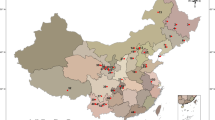Summary
DNA amplification fingerprinting using arbitrary primer(s) was applied to the identification of Malus species. Highly variable DNA fragment patterns were clearly detected by polyacrylamide gel electrophoresis of the amplified extension products, although three sports of Delicious exhibited the same fingerprint as the original cultivar. The fingerprinting of two triploid apple cultivars suggested that the parent contributing the 2n gamete was the female. We applied this fingerprinting to paternity analysis of an apple cultivar of which the pollen parent was unknown. By using 5 arbitrary primers and RFLP analysis of the amplified products, one cultivar was singled out for paternity among six putative candidates.
Similar content being viewed by others
References
Bacharach, A., 1982. Triploid apple cultivars have advantages. Am. Fruit Grow. June: 32.
Bassam, B.J., G. Caetano-Anolles & P.M. Gresshoff, 1991. Fast and sensitive silver staining of DNA in polyarcylamide gels. Anal. Biochem. 196: 80–83.
Bostein, D., R.L. White, M. Skolnick & R.W. Davis, 1980. Construction of a genetic linkage map in man using restriction fragment length polymorphisms. Am. J. Hum. Genet. 32: 314–331.
Bultitude, J., 1983. Apples. A guide to the identification of international varieties. The Macmillan Press Ltd.
Chyi, Y.S. & N.F. Weeden, 1984. Relative isozyme band intensities permit the identification of the 2n gamete parent of triploid apple cultivars. HortScience 19: 818–819.
Jeffreys, A.J., V. Wilson & S.L. Thein, 1985a. Hypervariable minisatellite regions in human DNA. Nature 314: 67–73.
Jeffreys, A.J., V. Wilson & S.L. Thein, 1985b. Individualspecific fingerpringts of human DNA. Nature 316: 76–79.
Nakamura, I., 1991. New DNA fingerprinting procedure: Amplified fragment length polymorphism of hazy associations (ALPHA). Ann. Rep. Nat. Ins. Genet. Japan 41: 105–107.
Norton, R.A., 1991. Apple cultivars—current situation and future trends in Japan. Fruit Varieties J. 45: 84–86.
Nybom, H., 1990a. Genetic variation in ornamental apple trees and their seedlings (Malus, Rosaceae) revealed by DNA fingerprinting with the M13 repeat probe. Hereditas 113: 17–28.
Nybom, H., 1990b. DNA fingerprints in sports of Red Delicious apples. HortScience 25: 1641–1642.
Nybom, H. & B.A. Schaal, 1990. DNA fingerprints applied to paternity analysis in applies (Malus x domestica). Theor. Appl. Genet. 79: 763–768.
Nybom, H., S.H. Rogstad & B.A. Schaal, 1990. Genetic variation detected by use of the M13 DNA fingerprint probe in Malus, Prunus, and Rubus (Rosaceae). Theor. Appl. Genet. 79: 153–156.
Rogstad, S.H., J.C. PattonII & B.A. Schaal, 1988. M13 repeat probe detects DNA minisatellite-like sequences in gymnosperms and angiosperms. Proc. Natl Acad. Sci. USA 85: 9176–9178.
Varadarajan, G.S. & C.S. Parakash, 1991. A rapid and efficient method for the extraction of total DNA from the sweet potato and its related species. Plant Mol. Biol. Rep. 9: 6–12.
Weeden, N.F. & R.C. Lamb, 1985. Identification of apple cultivars by isozyme phenotypes. J. Amer. Soc. Hort. Sci. 110: 509–515.
Welsh, J. & M. McClelland, 1990. Fingerprinting genomes using PCR with arbitrary primers. Nucleic Acids Res. 18: 7213–7218.
Welsh, J., R.J. Honeycutt, M. McClelland & B.W.S. Sibral, 1991. Parentage determination in maize hybrids using the arbitrarily primed polymerase chain reaction (AP-PCR). Theor. Appl. Genet. 82: 473–476.
Williams, J.G.K., A.R. Kubelik, K.J. Livak, J.A. Rafalski & S.V. Tingey, 1990. DNA polymorphisms amplified by arbitrary primers are useful as genetic markers. Nucleic Acids Res. 18: 6531–6535.
Wyman, A.R. & R. White, 1980. A highly polymorphic locus in human DNA. Proc. Natl. Acad. Sci. USA 77: 6754–6758.
Zeven, A.C. & J.M.J. de Wet, 1982. Dictionary of cultivated plants and their regions of diversity. Excluding most ornamentals, forest trees and lower plants. Centre for Agricultural Publishing and Documentation, Wageningen, p 43.
Author information
Authors and Affiliations
Rights and permissions
About this article
Cite this article
Harada, T., Matsukawa, K., Sato, T. et al. DNA-RAPDs detect genetic variation and paternity in Malus . Euphytica 65, 87–91 (1992). https://doi.org/10.1007/BF00022569
Received:
Accepted:
Issue Date:
DOI: https://doi.org/10.1007/BF00022569




